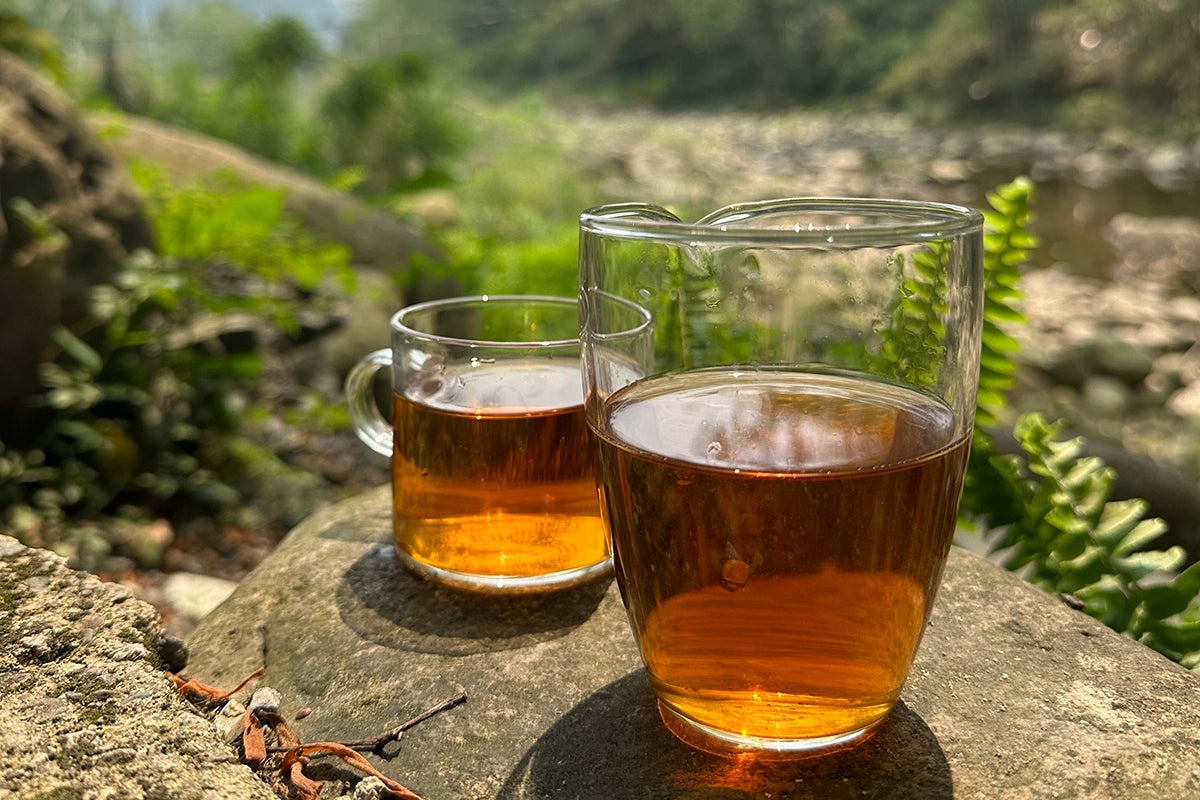Sounds great, right?
In reality, the situation could be much more complex, at least when it comes to Chinese wild tea.
What does wild tea in China mean?

If you find yourself near many artificially managed tea gardens, the chances of encountering wild tea trees are higher. Why is that?
Because there's often a connection between wild tea trees and the tea trees in local gardens. In some places, some tea trees in local tea gardens are cultivated from these wild tea trees, and there are many such cases in Yunnan, a region renowned for Chinese tea production. In other places, this situation is even more prevalent, where local wild tea trees were once part of managed gardens but were later abandoned. As a result, these trees have been growing naturally in the wild for many years.
In general, wild tea trees in China refer to tea trees growing in the wild without human intervention or management.
If left unmanaged, how do wild tea trees avoid insect bites?
- Insect bites aren't a concern.
As a result, it's common to see many insect holes on the leaves of wild tea trees. Occasionally, even freshly picked leaves may have insect holes. But this isn't a major issue. There's a famous Taiwanese oolong tea called Oriental Beauty, specifically known for its unique aroma and flavor achieved through insect bites on the tea leaves.

- Farmers may perform simple management on wild tea trees.
Is there a possibility that someone might spray pesticides on wild tea trees? This situation is possible but not very likely. Because many farmers currently harvest wild tea for their own tea drinking.

Generally, the likelihood of wild tea containing pesticides and fertilizers is much lower than that of tea from managed tea gardens. When purchasing wild tea, it's important to check for certifications from professional organizations to ensure that you're buying genuine Chinese organic loose leaf tea.
How is wild tea harvested?

Some wild tea trees have evolved from tea trees in managed gardens. These trees tend to grow in more concentrated areas, making harvesting somewhat easier.
On the other hand, harvesting wild tea trees scattered in forests is more challenging. Harvesters need to trek through the forest for extended periods. In the forest, you may also encounter some unusual companions such as snakes, so you need to be extra careful at such times.
What are the challenges in processing wild tea?
- Irregular fresh leaves

Therefore, fresh leaves from wild tea trees cannot be as uniform in specification as those from managed tea gardens, such as full buds or one bud and one leaf specifications. The irregularity of fresh leaves means that the processing of wild tea involves more randomness and uncertainty.
- Fresh leaves with unexpected moisture content

For example, if a tea master wants to make loose leaf green tea, the usual tea frying temperature and time may not be effective with wild tea leaves. If the tea master uses fresh leaves from wild tea trees to make loose leaf oolong tea, the time and intensity of the core processing step Yaoqing (shaking) also need to be adjusted accordingly. The outcome of Yaoqing (shaking) directly determines the success of making loose leaf oolong tea, which is crucial for producing the best oolong tea possible.
Is it worth the difficulty to pick and produce wild tea?
In China, although the yield of wild tea is not high, it has always been popular. From our experience of tasting wild tea, it stands out in terms of aroma and flavor. Some people prefer famous Chinese teas such as Longjing, Da Hong Pao, and Tie Guanyin, while others appreciate the unique flavor of wild tea. If you want to taste the flavor of best loose leaf tea, give wild tea a try.
Additionally, what's fascinating about wild tea is its wild charm, which is subjective. Some people believe that wild tea has a unique wild charm, while others find this feeling too subtle to discern.
If you want to experience this wild charm, you can compare wild tea with garden tea made using the same processing techniques. Garden tea tends to have a balanced taste across different levels, whereas wild tea also has corresponding taste levels but in a less balanced, irregular, and sometimes even rugged manner. If you have friends who are tea enthusiasts, you can choose tea gifts sets including wild tea for your friends. Your friends would be pleasantly surprised to receive wild tea.

Chinese tea offers a wide variety of types, not just wild tea; there are many interesting varieties available. Feel free to explore the world of Chinese tea through a loose leaf tea sampler.
We hope this sharing about wild tea has helped you gain more knowledge about tea and understand the stories behind these delicious teas.












































































